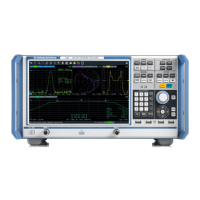Instrument Tour
R&S
®
ZNB/ZNBT
27Getting Started 1316.0062.02 ─ 26
The CHANNEL keys give access to the hardware-related (channel) settings.
●
The [POWER BW AVG] settings define the power of the internal signal source, the
IF bandwidth, and the sweep average.
●
The [SWEEP] settings define the scope of measurement, including the sweep type
and the number of measured sweeps.
●
[CAL] provides all functions that are necessary to perform a system error correction
(calibration).
●
[CHANNEL CONFIG] provides functions for channel management.
●
The [TRIGGER] settings control the start of the measurement sequence.
●
[OFFSET EMBED] provides a selection of length offset parameters to shift the
measurement plane.
The STIMULUS keys ([START], [STOP], [CENTER], [SPAN]) define the sweep range,
depending on the sweep type.
The SYSTEM keys provide general system settings.
●
[FILE] provides standard Windows
®
functions used to create, save, recall or print
recall sets, to copy the active screen and to shut down the application.
●
The [PRINT] settings control an external printer that is used to print a hardcopy of
the current recall set.
●
[APPLIC] gives access to external software tools and optional extensions of the
analyzer firmware.
●
[DISPLAY] gives access to all display settings and to the functions which activate,
modify and arrange different diagrams.
●
[SETUP] provides general system settings which are not restricted to a particular
recall set.
●
The Windows
®
key opens the startup menu of the Windows
®
operating system
from where you can perform system configurations and call up additional software
utilities.
●
[HELP] opens the context-sensitive help system of the analyzer.
●
[PRESET] performs a preset of the instrument settings.
3.1.3 Data Entry Keys
The keys in the DATA ENTRY keypad are used to enter numbers, units, and charac-
ters. The data entry keys are only enabled while the cursor is placed on a data input
field in a dialog or in the Help navigation pane.
●
The keys 0 to 9 enter the corresponding numbers.
●
The function of the "." and "–" keys depends on the data type of the active input
field:
– In numeric input fields, the keys enter the decimal point and a negative sign for
the entered numeric value. Multiple entries have not effect.
– In character input fields, the keys enter a dot and a hyphen, respectively. Both
entries can be repeated as often as desired.
Front Panel R&S
ZNB

